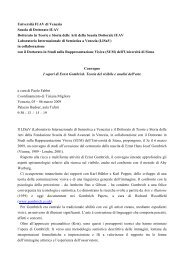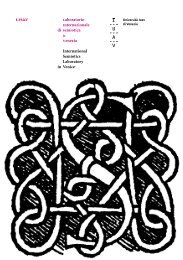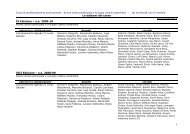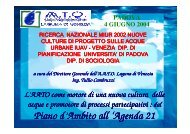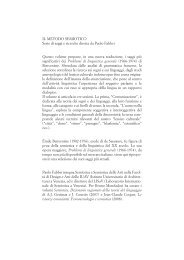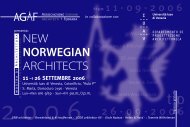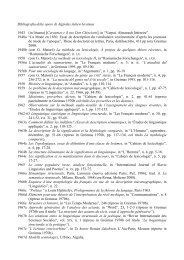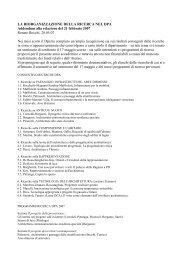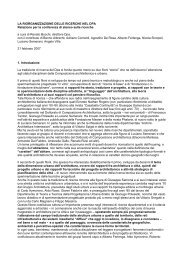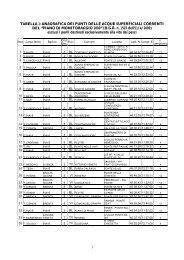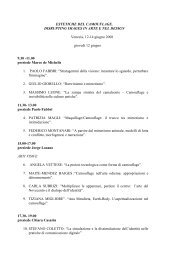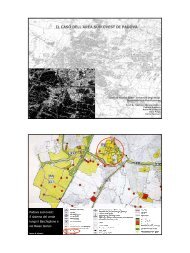I Saperi di Ernst Gombrich. Teoria del visibile e analisi dell'arte a ...
I Saperi di Ernst Gombrich. Teoria del visibile e analisi dell'arte a ...
I Saperi di Ernst Gombrich. Teoria del visibile e analisi dell'arte a ...
You also want an ePaper? Increase the reach of your titles
YUMPU automatically turns print PDFs into web optimized ePapers that Google loves.
I <strong>Saperi</strong> <strong>di</strong> <strong>Ernst</strong> <strong>Gombrich</strong>. <strong>Teoria</strong> <strong>del</strong> <strong>visibile</strong> e <strong>analisi</strong> <strong>del</strong>l'arte<br />
Paolo Fabbri e Tiziana Migliore, Venice University IUAV<br />
05-06/03/2009<br />
The LISaV (International Semiotic Laboratory in Venice) and the PhD Program in History and<br />
Theory of the Arts of the School for Advanced Stu<strong>di</strong>es of Venice, in collaboration with the PhD<br />
Program in Visual Stu<strong>di</strong>es of Siena University (SUM), are organizing a Colloquium about <strong>Ernst</strong><br />
Hans Josef <strong>Gombrich</strong> (Wien, 1909 – London, 2001), that should be held on March 5-6 2009 in<br />
Venice.<br />
The aim of the Colloquium is to investigate some specific issues among the multifarious activities<br />
and interests of <strong>Ernst</strong> <strong>Gombrich</strong>, in order to mainly focus on the epistemological aspects related to<br />
his theory of the image, also comparing it with Aby Warburg’s approach to art history.<br />
The Colloquium will then consider the relations between <strong>Ernst</strong> <strong>Gombrich</strong>, Karl Bühler and Karl<br />
Popper and analyse the development of a theory of visual communication, with particular regard to<br />
a Visual Linguistics.<br />
The <strong>di</strong>alectical exchange with the psychology of perception – from Arnheim to Gibson – lead<br />
<strong>Gombrich</strong> to a productive convergence of iconology and semiotics. This is shown by the researches<br />
carried out by <strong>Gombrich</strong> since Art and Illusion (1959) and today it is witnessed by the <strong>Gombrich</strong><br />
Papers, e<strong>di</strong>ted by Richard Woodfield (www.gombrich.co.uk).<br />
<strong>Gombrich</strong>’s key issue regarded the tra<strong>di</strong>tional ability with which artists create, through visual<br />
devices, a universe of meaningful illusions. Art is then illusion since it is a construction of a<br />
language.<br />
Together with a psychoanalytical approach instigated by <strong>Ernst</strong> Kris, these are the theoretical<br />
assumptions that addressed <strong>Gombrich</strong> toward 1) a semiotic methodology to describe pictures,<br />
<strong>di</strong>fferent from formalistic or impressionist interpretations and 2) a valorisation of the relation<br />
between the artistic image and the experience of the viewer.<br />
The Colloquium will take place in two days, during which international and Italian scholars, mainly<br />
from the IUAV University of Venice, will <strong>di</strong>scuss about the abovementioned issues.



